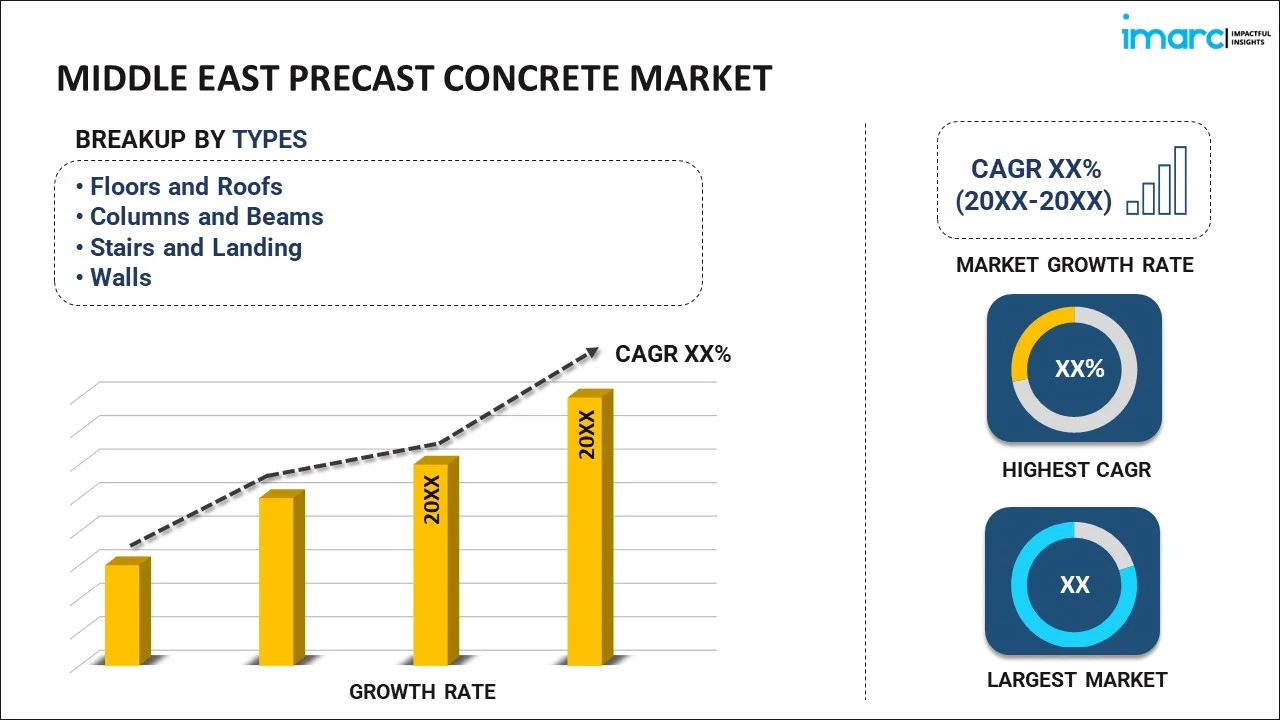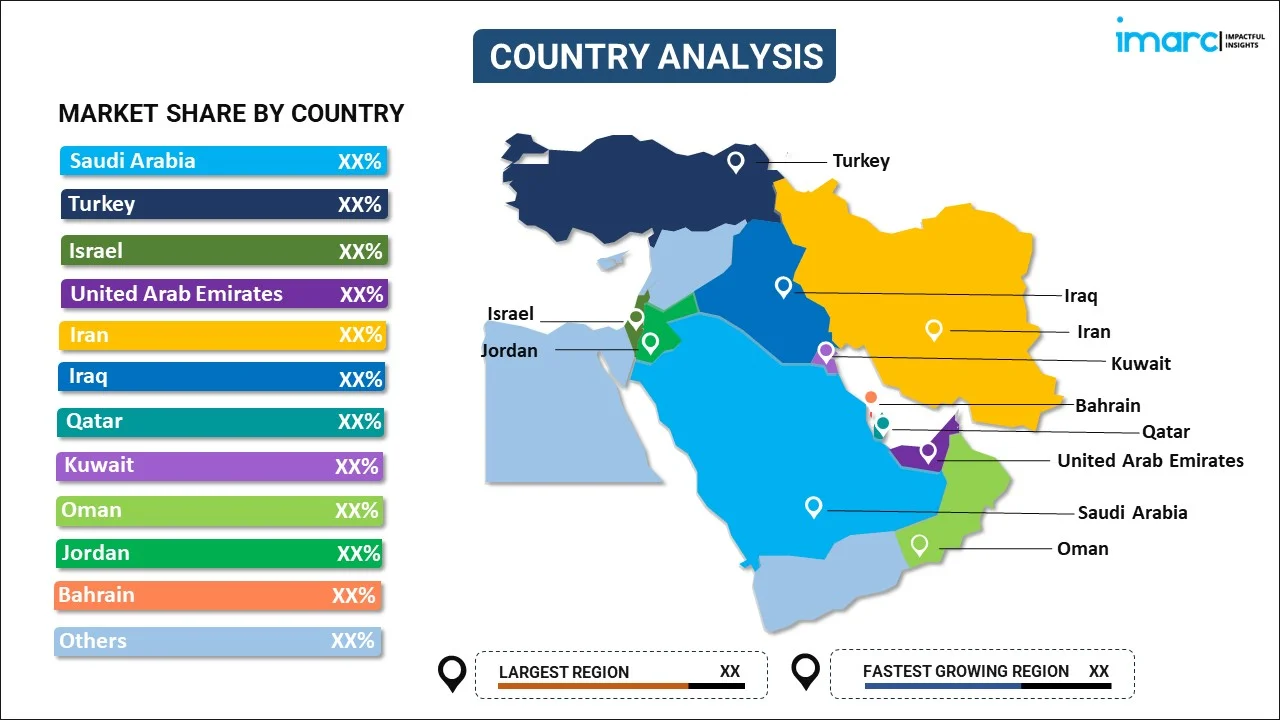
Middle East Precast Concrete Market Report by Type (Floors and Roofs, Columns and Beams, Stairs and Landing, Walls), Product (Structural Building Components, Architectural Building Components, Transportation Products, Water and Waste Handling Products, and Others), End Use (Residential, Non-Residential), and Country 2025-2033
Market Overview:
Middle East precast concrete market size is projected to exhibit a growth rate (CAGR) of 5.6% during 2025-2033. The increasing construction of residential and commercial buildings in urban settings, rising adoption of prefabricated modular construction methods, and the growing environmental awareness among the masses represent some of the key factors driving the market.
|
Report Attribute
|
Key Statistics
|
|---|---|
|
Base Year
|
2024 |
|
Forecast Years
|
2025-2033
|
|
Historical Years
|
2019-2024
|
| Market Growth Rate (2025-2033) | 5.6% |
Precast concrete is a construction material that is manufactured off-site in a controlled environment and then transported to the construction site for installation. It exhibits exceptional strength and durability, making it suitable for a wide range of applications, including structural components. Its controlled manufacturing process ensures consistent quality and uniformity in precast concrete products, reducing variations in construction. It can be customized to meet specific project requirements, including various shapes, sizes, textures, and finishes. It offers excellent fire resistance properties and can withstand harsh weather conditions, including freeze-thaw cycles, making it suitable for both indoor and outdoor applications. It is eco-friendly as it minimizes waste, energy consumption, and the carbon footprint associated with on-site construction. It is widely used in residential, commercial, and industrial buildings for walls, beams, columns, and facades. It is employed in infrastructure projects, such as bridges, tunnels, retaining walls, and highway sound barriers. Moreover, it is utilized for water treatment plants, sewage systems, and stormwater management structures. It can also be tailored for specialized applications, including highway barriers, precast concrete pipes, and even decorative elements. Besides this, as it has a longer lifespan and requires less maintenance and replacement costs over time, the demand for precast concrete is increasing across the Middle East.
Middle East Precast Concrete Market Trends:
Rapid urbanization and the rising need for housing represent one of the primary factors driving the demand for precast concrete in the Middle East. Additionally, the increasing construction of commercial buildings in urban settings is catalyzing the demand for precast concrete. Along with this, increasing construction of commercial buildings in urban settings in the Middle East is catalyzing the demand for precast concrete as it has a lower carbon footprint compared to traditional on-site construction methods. Furthermore, the public and private sectors in the region are investing heavily in infrastructure development, which is driving the demand for precast concrete due to its durability and ability to accelerate construction schedules. Moreover, continuous technological advancements in the construction industry are strengthening the growth of the market. Computer-aided design (CAD), building information modeling (BIM), and automation are improving the precision and efficiency of precast concrete manufacturing. BIM facilitates collaborative project management, allowing stakeholders to visualize and plan projects in detail, reducing errors and enhancing project efficiency. These innovations enhance product quality and reduce production time. Along with this, the widespread adoption of prefabricated modular construction methods is supporting the market growth. In addition, the rising remodeling and retrofitting of aging infrastructure in many countries of the region is catalyzing the demand for precast concrete.
Middle East Precast Concrete Market Segmentation:
IMARC Group provides an analysis of the key trends in each segment of the market, along with forecasts at the regional and country levels for 2025-2033. Our report has categorized the market based on type, product, and end use.
Type Insights:

- Floors and Roofs
- Columns and Beams
- Stairs and Landing
- Walls
The report has provided a detailed breakup and analysis of the market based on the type. This includes floors and roofs, columns and beams, stairs and landing, and walls.
Product Insights:
- Structural Building Components
- Architectural Building Components
- Transportation Products
- Water and Waste Handling Products
- Others
A detailed breakup and analysis of the market based on the product have also been provided in the report. This includes structural building components, architectural building components, transportation products, water and waste handling products, and others.
End Use Insights:
- Residential
- Non-Residential
The report has provided a detailed breakup and analysis of the market based on the end use. This includes residential and non-residential.
Country Insights:

- Saudi Arabia
- Turkey
- Israel
- United Arab Emirates
- Iran
- Iraq
- Qatar
- Kuwait
- Oman
- Jordan
- Bahrain
- Others
The report has also provided a comprehensive analysis of all the major regional markets, which include Saudi Arabia, Turkey, Israel, United Arab Emirates, Iran, Iraq, Qatar, Kuwait, Oman, Jordan, Bahrain, and Others.
Competitive Landscape:
The market research report has also provided a comprehensive analysis of the competitive landscape in the market. Competitive analysis such as market structure, key player positioning, top winning strategies, competitive dashboard, and company evaluation quadrant has been covered in the report. Also, detailed profiles of all major companies have been provided. Some of the key players include:
- ACICO Group
- Bina Precast
- Dubai Precast LLC
- Gulf Precast Concrete Co. LLC
(Please note that this is only a partial list of the key players, and the complete list is provided in the report.)
Middle East Precast Concrete Market Report Coverage:
| Report Features | Details |
|---|---|
| Base Year of the Analysis | 2024 |
| Historical Period | 2019-2024 |
| Forecast Period | 2025-2033 |
| Units | Million USD |
| Scope of the Report | Exploration of Historical and Forecast Trends, Industry Catalysts and Challenges, Segment-Wise Historical and Predictive Market Assessment:
|
| Types Covered | Floors and Roofs, Columns and Beams, Stairs and Landing, Walls |
| Products Covered | Structural Building Components, Architectural Building Components, Transportation Products, Water and Waste Handling Products, Others |
| End Uses Covered | Residential, Non-Residential |
| Countries Covered | Saudi Arabia, Turkey, Israel, United Arab Emirates, Iran, Iraq, Qatar, Kuwait, Oman, Jordan, Bahrain, Others |
| Companies Covered | ACICO Group, Bina Precast, Dubai Precast LLC, Gulf Precast Concrete Co. LLC., etc. |
| Customization Scope | 10% Free Customization |
| Post-Sale Analyst Support | 10-12 Weeks |
| Delivery Format | PDF and Excel through Email (We can also provide the editable version of the report in PPT/Word format on special request) |
Key Questions Answered in This Report:
- How has the Middle East precast concrete market performed so far and how will it perform in the coming years?
- What has been the impact of COVID-19 on the Middle East precast concrete market?
- What is the breakup of the Middle East precast concrete market on the basis of type?
- What is the breakup of the Middle East precast concrete market on the basis of product?
- What is the breakup of the Middle East precast concrete market on the basis of end use?
- What are the various stages in the value chain of the Middle East precast concrete market?
- What are the key driving factors and challenges in the Middle East precast concrete?
- What is the structure of the Middle East precast concrete market and who are the key players?
- What is the degree of competition in the Middle East precast concrete market?
Key Benefits for Stakeholders:
- IMARC’s industry report offers a comprehensive quantitative analysis of various market segments, historical and current market trends, market forecasts, and dynamics of the Middle East precast concrete market from 2019-2033.
- The research report provides the latest information on the market drivers, challenges, and opportunities in the Middle East precast concrete market.
- Porter's five forces analysis assist stakeholders in assessing the impact of new entrants, competitive rivalry, supplier power, buyer power, and the threat of substitution. It helps stakeholders to analyze the level of competition within the Middle East precast concrete industry and its attractiveness.
- Competitive landscape allows stakeholders to understand their competitive environment and provides an insight into the current positions of key players in the market.
Need more help?
- Speak to our experienced analysts for insights on the current market scenarios.
- Include additional segments and countries to customize the report as per your requirement.
- Gain an unparalleled competitive advantage in your domain by understanding how to utilize the report and positively impacting your operations and revenue.
- For further assistance, please connect with our analysts.
 Inquire Before Buying
Inquire Before Buying
 Speak to an Analyst
Speak to an Analyst
 Request Brochure
Request Brochure
 Request Customization
Request Customization




.webp)




.webp)












